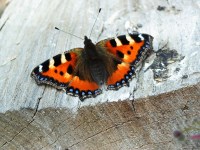 |
| Our Garden back in June…a distant memory just now. |
Whilst casually browsing yesterday and reviewing unread tweets I stumbled upon a useful article on The 99 Percent. The article was listing the top 10 programs available that help improve or maintain focus. By the way, the irony of me spending the afternoon reading blogs about improving focus was not lost on my beloved. One of the programs particularly intrigued me however and I couldn’t resist downloading it. It’s called Focus Writer.
The purpose of this program is to concentrate the train of thought into writing, and solely writing. The theory goes that the various buttons, tabs, taskbars and further program buttons can act as distractions and being able to visualise other program actions such as incoming email etc can lead to you being metaphorically dragged from the pressing task in hand, which is your writing.
Now, I don’t have much in the way of creative writing to do. I have a blog to try and keep up to date and tweets to keep tweeting. Garden designs need presentation text and our website gets updated every now an again. but I can still see the value of this deceptively simple little program. Firstly, it has spurred me on to start writing this little ditty which, if I keep going which it would appear I’m going to do, will probably find its way into my blog somewhere. Secondly, what little writing I do, and in the cosmic scheme of my business it is tiny, I still feel oftentimes that it is taking me way longer than it should be, so any mechanism, or in this case a clever program, that can allow me to expedite my literary responsibilities efficiently and with minimum disruption to other areas of the business has got to be a good thing.
The primary function of the program is to zone out all other programs and it does this by completely blanking out your screen with the ‘notepaper’. There are no buttons, function keys, taskbars or scrollbars visible. All you start with are a grey page and an expectantly blinking cursor. It has the look of a vintage typewriter or word-processor. There is functionality though. Should you move the mouse towards the top, bottom or side you will get pop-out menus for further editing options. It has a performance bar if you drag the mouse to the bottom that tracks word count and time spent typing. The coolest feature though, in my opinion, is the little tic-tic-tic sound you get every time you hit a keystroke. It’s about the most therapeutic sound I’ve heard in a long time.
Beyond the new focus enriching software though I’m now into my fourth week of not being able to do ‘outside’ gardening. To say I’m getting frustrated would be an understatement. I’ve been commissioned to carry out the build of a further two of our designs and I can’t wait to get started but alas the gods seem insistent in keeping the temperatures at an average this week of -8 degrees.
Work still needs doing though and we’ve been approached to design a community garden in the local Provost Park by the Friends of Bridge of Allan, a local community volunteer group. They do sterling work keeping the green areas in our village looking top banana. Their hard work was recently recognised by Beautiful Scotland with Bridge of Allan receiving the accolade of Best Small Town 2010. The site has been cleared due to adjacent building work but now requires to be revived as a nice relaxing space for the community to enjoy. We can’t wait to get started.
Before I sign off I’d like to give a hearty thanks to all our customers who have supported Vialii Garden Design and Vialii Garden Services this year and take the opportunity to wish you all a Merry Christmas and a Happy New Year.
Michael – Vialii Garden Design
– As I write I’m listening to Kings of Leon – Because of the Times
– The photo above is of our back garden which was completed in the summer of 2010. I thought it’d be nice to see what I’m missing at the moment and to visualise what I can look forward to getting tucked into next year.
















